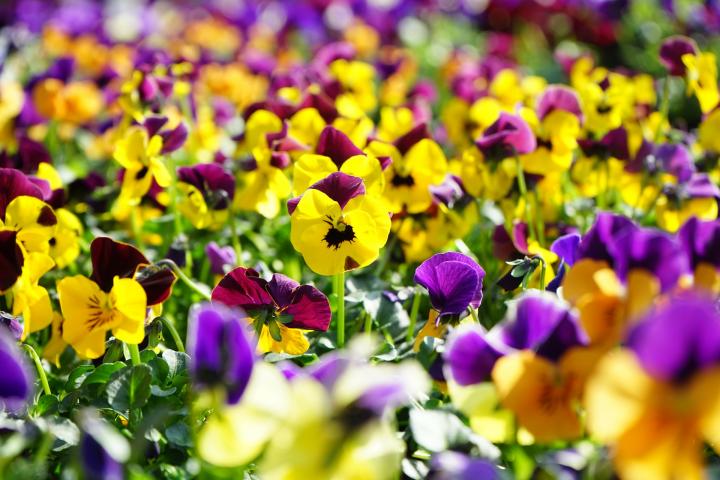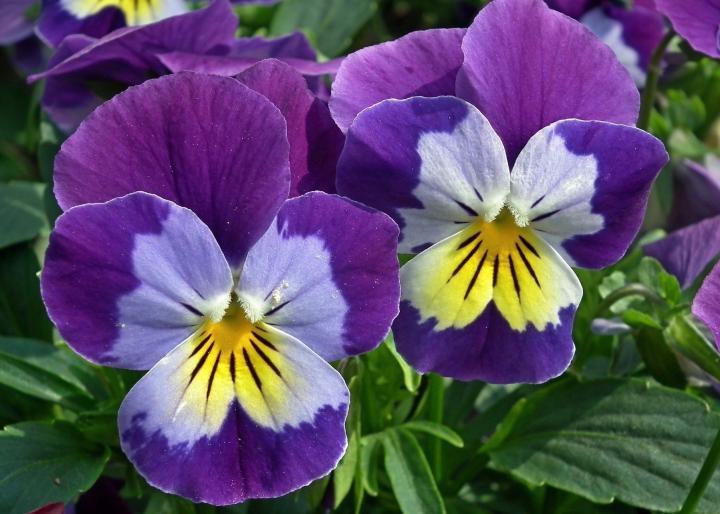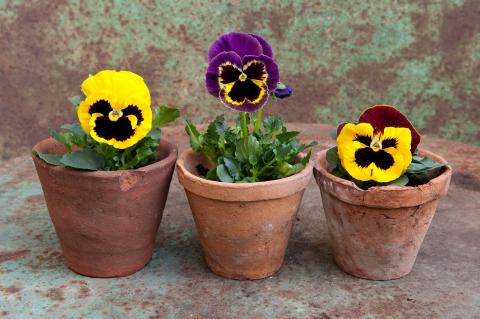Pansies are the colorful flowers with “faces.” A cool-weather favorite, pansies are great for both spring and fall gardens! Here’s how to plant pansies as well as keep them growing and blooming.
About Pansies
Pansies have heart-shaped, overlapping petals and one of the widest ranges of bright, pretty colors and patterns.
Good for containers, borders, and as ground cover, they are a go-to flower for reliable color almost year-round in some places. Pansies look pretty on their own in a monochrome scheme or in mixed colors; they also look pretty when planted with other cool-season flowers such as violas, primroses, trailing lobelia, and sweet alyssum.
Are Pansies Annual or Perennial Flowers?
The pansy may be treated as either an annual or a perennial, depending on your climate. However, most gardeners treat this plant as an annual because it prefers cool weather and gets too leggy in the heat of summer. There hasn’t been much success in producing heat-tolerant pansies that can adequately survive hot weather.
Pansies are surprisingly hearty in cold weather, though. They’ll survive a frost, bouncing back from even single digit temperatures. If the blooms wither in the cold, the plants will often stay alive to bloom again, which makes them a great flowering plant for fall and early winter color.

When to Plant Pansies
- Pansies can be planted in the early spring or in the fall.
- Pansies can be finicky to start from seed; it’s a lot easier to buy established plants from a local nursery. Plus, you’ll get blooms a lot sooner.
- But if you want to start from seed, start pansy seeds indoors in late winter 8 to 10 weeks before the last spring frost for early spring and summer flowering. Or, start seeds in late summer for fall and winter flowering. Pansy seeds may be slow to germinate (typically emerging in anywhere from 1 to 3 weeks, depending on soil temperature).
- Set pansy plants in the ground when it becomes workable in the spring. They grow best when soil temperatures are between 45°F and 65°F (7°C and 18°C).
- Pansies can tolerate a light frost just after planting, but try to hold off on putting them in the ground if temperatures are still regularly reaching well below freezing.
Where to Plant Pansies
- Plant in moist, humus-rich, well-drained soil. See our articles on soil amendments and preparing soil for planting for more information.
- Pansies like full or partial sun, but need cooler temperatures to thrive. The ideal planting site will get morning sun but avoid the heat of the late afternoon.
- Space the plants about 7 to 12 inches apart. They will spread about 9 to 12 inches and grow to be about 6 to 9 inches tall.
Pansies in Pots
- Pansies are great for containers. Just use standard potting soil designed for containers.
- Plant in portable containers (12 inches or less in diameter) so the plants can be moved to a cooler area when the sun starts to get stronger. Early in the spring season or in the fall, a south-facing patio might be the perfect spot. During the summer, move pansies to the east side of your home for morning sun and afternoon shade.
How to Care for Pansies
- Remember to water pansies regularly. One of the most common reasons pansies fail is because they are not watered enough, so if your pansies are not doing well, try watering them more.
- You can use a general, all-purpose fertilizer around your pansies to help them grow. Be wary of using a nitrogen-heavy fertilizer, though, as this can result in more foliage instead of flowers.
- Remove faded/dead flowers to encourage the plants to produce more blooms and to prolong the blooming season.

- Mosaic viruses
- Downy mildew
- Powdery mildew
- Crown rot and root rot
- Rust
- Gray mold
- Spot anthracnose
- Slugs, snails, and aphids
- ‘Jolly Joker’, which blooms in spring and summer and has orange flowers with deep purple upper petals and a purple outline.
- Princess Series, which offer a variety of colors such as blue, purple, and yellow.
- Fama Series, which flowers in winter and spring and offers a wide variety of single- and mixed-colored flowers.
See 10 pansy varieties and pretty pictures!
- Pansies symbolize “thinking” or “thoughts.” The word “pansy” itself comes from French pensée, meaning “thought.” Find out more flower meanings here.
- Pansies are one of several edible garden flowers! They have a mild minty flavor and make for a lovely edible flourish on a salad or dessert.




